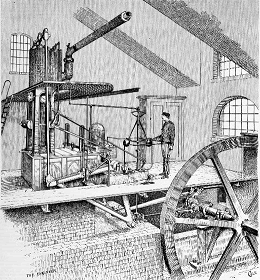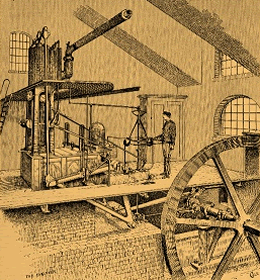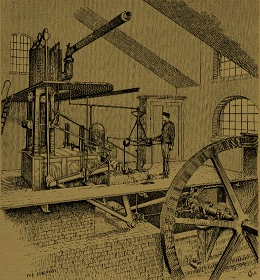Birmingham
- From plateau to port
- Birmingham’s Canals
- Birmingham’s population
- The metal industry: Matthew Boulton
- Birmingham, ’“The Toyshop of Europe”
From plateau to port
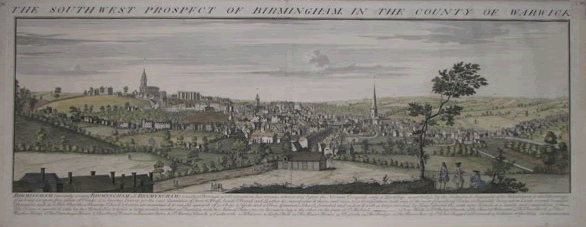
- The Southwest prospect of Birmingham in the county of Warwick
- Engraving by Nathaniel Buck (1731). Birmingham is built on a plateau, as shown on the engraving. On the plateau to the left of the engraving the new church of St Philip’s; in the valley to the right the mediaeval spire of St Martin’s.
[click on the picture to enlarge it]
The text under the engraving reads:
Birmingham (anciently written Birmyncham or Brymyncham) is neither a Borough or Corporation; but remains what it was before the Norman Conquest, only a Lordship: nevertheless, by the Industry and Ingenuity of its Inhabitants, & the Advantage of its being an open free place of Trade, it is become famous for the vast quantities of Iron & Brass, besides Thread and Leather &c manufactures there, and risen to a Competition with any of the most flourishing Towns in England; being adorn’d with several beautiful Structures, such as a New Church; a Charity School, wherein are maintain’d & taught upwards of 50 boys & girls; and a free grammar school, founded and endow’d with a large revenue by King Edward the sixth now rebuilt in a stately and comodious form. The Town is govern’d only by two Constables, & holds a large weekly market on Thursday, with two annual Fairs, one on Ascension Day, and the other on the Feast of St Michael.
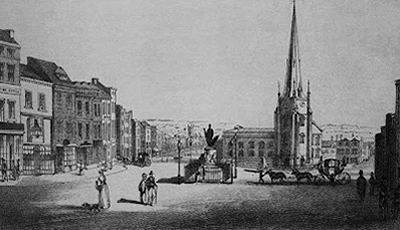
- St Martin’s from the Bull Ring area
- An 1811 engraving of St Martin’s from the Bull Ring area, by Hollins, with Nelson’s statue by Westmacott (1809) in the middle; the view shows the fall of the land, with St Martin’s on a lower level.
[click on the picture to enlarge it]
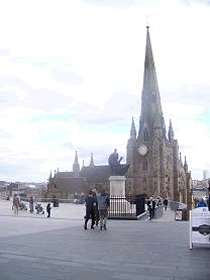
- St Martin’s from the Bull Ring area
- A present-day view of the statue and the church from approximately the same standpoint, showing the fall of the land.
[click on the picture to enlarge it]
Its industrial activities were made possible by the neighbouring iron and coal deposits, and by the descending streams caused by the slopes of the plateau, which could power the machinery. The position, favourable to production, was inconvenient for transport, and the town specialised in small highly valuable goods, easy to carry, made by skilled workmen. Birmingham then needed better transport, and in the second half of the 18th century it became a major inland port thanks to its canal network, which meant building flights of locks from the valleys to the plateau.
Birmingham’s Canals
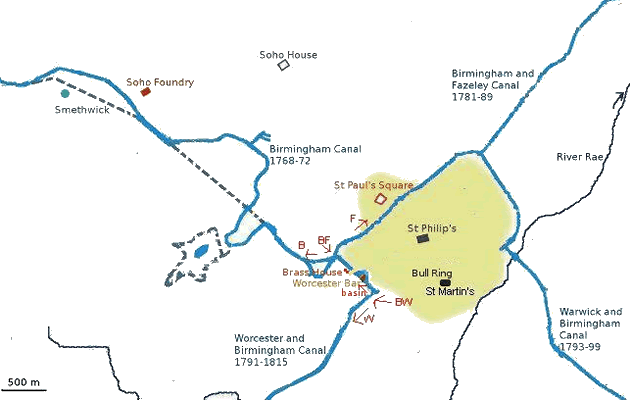
- Map of Birmingham
- [click on the picture to enlarge it]
18th century canals
straightened canal (1820s) and reservoir
natural rivers and brooks (non navigable)
built areas in the late 18th century
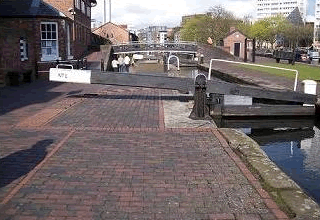
- F: the locks of the Birmingham and Fazeley Canal
- [click on the picture to enlarge it]
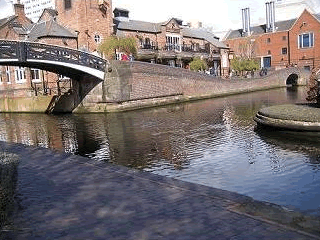
- BF: The junction of the Birmingham Canal (foreground right) and the Birmingham and Fazeley Canal (middle distance left), with the reach leading towards the basin (in the distance to the right)
- [click on the picture to enlarge it]
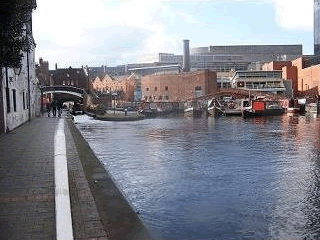
- the basin: the island in the middle linked by a bridge to the quay; on the left the Worcester Bar
- [click on the picture to enlarge it]
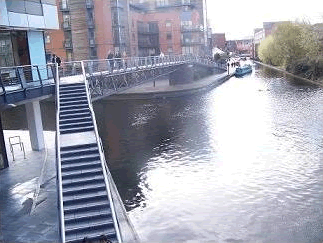
- BW: the junction of the basin and the Worcester and Birmingham Canal (to the left)
- [click on the picture to enlarge it]
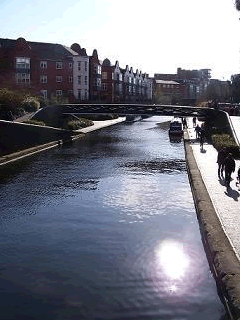
- B: the Birmingham Canal
- [click on the picture to enlarge it]
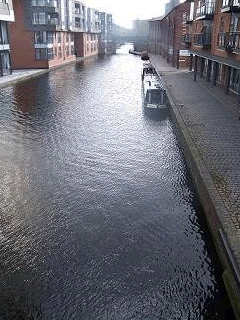
- W: Right: the Worcester and Birmingham Canal
- [click on the picture to enlarge it]
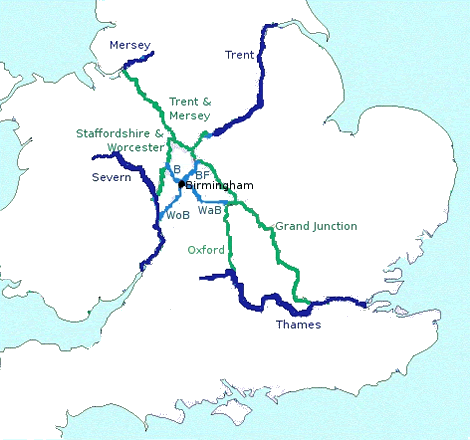
- Birmingham’s Canals
- [click on the picture to enlarge it]
rivers
Grand Cross canals
Birmingham canals:
- B: Birmingham Canal
- BF: Birmingham & Fazeley Canal
- WaB: Warwick & Birmingham Canal
- WoB: Worcester & Birmingham Canal
The map shows how Birmingham was connected, through its four canals, to the Grand Cross Canals, and through them to the four main rivers reaching the seas NW, NE, SE, SW.
It was also, through the Grand Cross Canals, linked to minor canals (not shown here) and had numerous interconnections to the canal network. There was a Canal Navigation Office not far from the central basin.
Birmingham’s newly acquired importance in the age of industrialisation is partly due to its central geographical position, when the ’Grand Cross’ of canals was completed, with its centre in the Birmingham area, as previously it was badly served by roads, though journey times improved from three days to fifteen hours for a journey to London.
It was first linked (North West) to the Staffordshire and Worcester canal, by the ’Birmingham Canal’ flowing through coalfields (1768-72), which was straightened in the early 19th century when ’cuts’ became easier to construct. It needed a Boulton steam engine to pump water (See below – chapter on ‘The metal industry : Matthew Boulton’, paragraph on the steam engine for the Birmingham canal).
To the North East, Birmingham was connected (1780s) by the ’Birmingham and Fazeley Canal’ - connecting with the Birmingham Canal - to the Trent and Mersey Canal in the North, by joining first the Oxford/Coventry Canal which led northwards to the Trent and Mersey Canal, and which could also lead southwards to the Thames.
To the South East, the Warwick and Birmingham Canal (1790s) connected a branch of the Birmingham and Fazeley Canal to the Oxford Canal, and thus to the Thames.
It was then (1790s onwards) linked South West to the Severn by the ’Worcester and Birmingham Canal’, which terminated close to the Birmingham Canal but at first was not allowed to connect with it, in order to avoid emptying its water, so that the ’Worcester Bar’ separated them and goods had to be unloaded and reloaded; a lock between them was built in 1815, on condition that the barges would pay a toll.
The central basin (on the map above, near the Brasshouse and the Worcester Bar) was originally cut as a ’tuning fork’ of two unloading bays (as in Manchester) to allow for simultaneous unloading of two barges so as to speed delivery.
Birmingham’s population
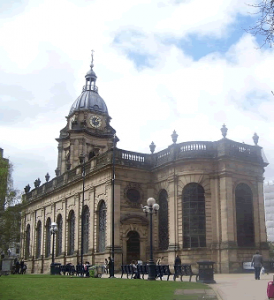
- St Philip’s Church
- St Philip’s Church (early 18th century)
[click on the picture to enlarge it]
Birmingham had a population of 10000 inhabitants in the early 18th century, around 65000 in the the mid 18th century, 100000 in the early 19th century. The town expanded from the mediaeval area around St Martin’s, towards the North around St Philip’s. Rows of Georgian buildings were then erected on land sold off by a local family, the Colmore family whose name survives in a street, such as the St Paul’s area in the 1770s; the precious metal industry settled there - mountmakers, engravers- now the Jewellery Quarter.
William Hutton (1723-1815), now a bookseller near the Bull Ring and the first historian of Birmingham, wrote :
I was surprized at the place, but more at the people. They possess a vivacity I had never beheld. I had been among dreamers, but now I saw men awake. Their very step along the street showed alacrity. Every man seemed to know what he was about. The Town was large, and full of inhabitants, and those inhabitants full of industry.
In his History of Birmingham (1782), Hutton believed that the lack of municipal government (mentioned in the legend to Buck’s engraving above) - there were only a small number of officials such as bailiffs and street commissioners - was actually beneficial since it encouraged the spirit of initiative from those outside influential institutions: ’a town without a charter is a town without a shackle’.
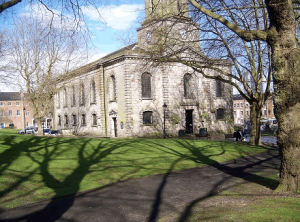
- St Paul’s Square
- St Paul’s Square, the last remaining Georgian square, with the brick terrace houses around it, and the church (the spire is later).
[click on the picture to enlarge it]
The scientist Joseph Priestley, who was a Non-Conformist minister, had his laboratory in Birmingham; his house and his apparatus were burnt in a riot by an anti-revolutionary crowd (1791) because he was sympathetic to the French Revolution; so was Hutton’s house (also a Non-Conformist).
The printer Baskerville worked near the Bull Ring - his name remains as that of a printing type fount.
There were operatives from central Europe skilled in the working of ruby glass, and French enamellers in High Street (near the Bull Ring).
Industry was supported by a banking system, frequently, as often then, carried on by the industrialists themselves, such as the owner of iron works Sampson Lloyd. Commercial relations with foreign governments were led by the button maker Edward Thomason based near St Philip’s, who liaised with them.
There was a gazette, Aris’s Birmingham Gazette (from 1741) and later a directory, Bisset’s Directory (several editions, 1800, 1808). There was a theatre (1774) and a subscription library (1779), a General Hospital (1779) and concerts at St Philip’s to raise funds for it.
At the end of the period, Charles Dyer, in A Description of Modern Birmingham (1818), wrote that the town was ’distinguished for a spirit of enterprise and persevering industry. Its inhabitants are continually inventing some new articles, or making improvements in others, and by their superior skill, are enabled to bring into the foreign market an endless variety of manufactured goods, both useful and ornemental.’
(a large part of the information in this paragraph is derived from the new History Galleries in Birmingham Museum and Art Gallery, opened in late 2012).
The metal industry: Matthew Boulton
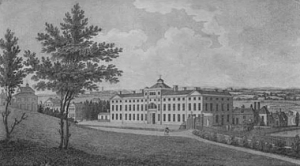
- Soho Manufactory
- An engraving of Soho Manufactory, by Francis Eginton, published in Bissett’s Directory, 1800. The lake is visible to the right.
Other similar engravings were published in Stebbing Shaw’s The History & Antiquities of Staffordshire, 1801.
A view for the French public (with legend in French) was published earlier by Eginton (1773).
[click on the picture to enlarge it]
Matthew Boulton’s Soho Manufactory in the Northern suburbs of Birmingham (built 1761-65), left, now demolished - exterior view, engraving by Eginton, published in Stebbing Shaw’s - Bissett ). The building, an early example of factory structure with activities of the different trades all in one building, from raw material to warehousing, and with design rooms. Being an unusually large building, it was well ventilated and bright. It manufactured a large number of metal objects; Boulton settled there for the water power of a brook. He first produced buckles and buttons - then known as ’toys’ (not children’s playthings, but fancy goods), then added decorative and household objects in silver - sterling or plated -, and ormolu (plated gold); he thus catered both for the aristocratic market needing precious goods, and for the middle-class one needing cheaper replicas. He frequently took ancient objects as models, according to the taste of the day.
The Manufactory employed several hundred highly-skilled workers, usually trained on the spot; Boulton founded an Insurance Society to which the workers contributed to obtain pay in case of sickness. Soho Manufactory could be visited by travellers interested in industry, who would take a factory tour, visit the showroom, and could make donations to the Insurance fund.
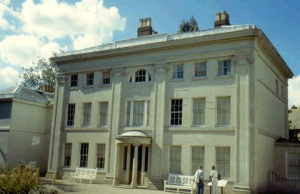
- Matthew Boulton’s house
- [click on the picture to enlarge it]
Matthew Boulton’s house in Handsworth, near Birmingham (inhabited from 1766, remodelled in the 1790s, right), close to the Manufactory. It contained structural elements and decorative objects manufactured at Soho Manufactory, such as metal glazing bars or fanlights, ormolu vases and plate candelabra, frequently with ancient neo-classical motifs, and a clock with movement by Whitehurst of Derby incorporating ideas from Harrison’s chronometer, constructed in Soho Manufactory in 1771.
He was a member of the Lunar Society whose members met there in turn; the rooms where they met, and Boulton’s study, may still be seen, together with his inventions: a heating system after the Roman process of the hypocaust, and a copying machine by Watt using a chemical process, the original written in slow-drying ink and passing through a press to make the duplicate on tissue paper. Boulton had a laboratory in the factory, where he practised chemistry, astronomy and optics, experiments on electricity and on thermometers; some of the experiments were related to factory processes, others were Boulton’s personal interests (information from Soho House).
The area was a pioneering industrial and scientific area.
Boulton obtained the foundation of an Assay Office for silverware (still in existence) in Birmingham in 1773, so as to avoid having to send metal to Chester for hallmarking; as the petitioners for the assay met at the Crown and Anchor Inn, an anchor became the Birmingham hallmark (information from the Jewellery Quarter Museum).
Boulton associated with Watt who improved the steam engine because water power, which proved insufficient - at first the steam engine was used to supplement water power, to pump water back and put in the circuit again; then steam engines were used in the manufacturing process. Their biographies were told by the 19th-century author of Lives of the Engineers, Samuel Smiles.
They improved the minting of currency at Soho Mint (close to Soho Manufactory) from 1788 onwards, using steam power to make coins, with techniques meant to avoid forgery; in 1797 he won the government contract for copper coins, and in 1799 he supplied the Royal Mint with coining machinery. The reliable currency which ensued contributed to the development of the economy.

- The Brasshouse
- [click on the picture to enlarge it]
In 1780, the Birmingham brass founders decided to produce their brass themselves directly from the raw materials to avoid depending on the brass from Bristol, which had increased its price; the canals now made the transport of raw materials easier. The brasshouse was founded by Boulton in 1781; it is shown in an engraving, but the chimneys have now disappeared.
The Brasshouse (to the left at the corner of the canal); the foreground street is over a bridge under which is the tunnel through which the canal passes perpendicularly, from the basin (behind us) to the junction (in the distance in the middle of the photo) of the Birmingham canal and the Birmingham and Fazeley canal; the canal is lined by houses on both sides.
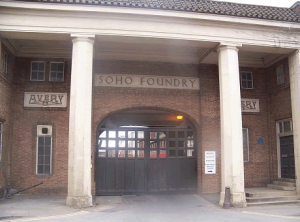
- The Soho Foundry (present state)
- [click on the picture to enlarge it]
Boulton and Watt’s role in the construction of steam engines was first to sell the process to industrialists and advise them on the building of the engines on site. Among those who manufactured the pistons was Wilkinson in his ironworks (near Chester). When he ceased working, Boulton and Watt founded the Soho Foundry near the Birmingham canal in 1795 (parts of the building are still in existence at the back, used by another firm now), to build the engines themselves, with lathes to shape pieces of metal as parts of steam engines. As a competitor, they later had the machine of Murray of Leeds (1802), whose smaller engines were easily made in his factory and transported to his clients’ sites (information from the Thinktank, the Birmingham museum of industry).
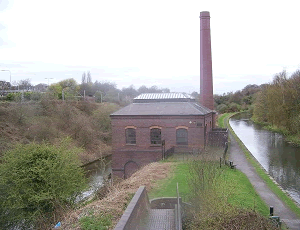
- Steam engine for the Birmingham canal
- [click on the picture to enlarge it]
Boulton and Watt built a steam engine for the Birmingham canal at Smethwick in 1779. The canal needed several locks up and down the hill, the upper locks losing 100 000 liters for each boat; the steam engine of 30 horsepower pumped water back to the upper reaches. The engine, the oldest working steam engine in existence, is now in the Thinktank museum.
The Birmingham Canal at Smethwick. To the right, the first canal, on a high level and needing locks up and down; to the left, the later circuit of the canal in a much deeper cut. The engine house in the middle dates from the late 19th century, replacing Boulton and Watt’s 1779 engine.
In factories, gaslight was useful to have brighter working places and to respond to the need for 24-hour factories. It was developed by William Murdock, a manager of Boulton and Watt, in the 1790s, and used in the Soho Foundry in 1798, then outside it in 1802. Experiments on gaslighting had just been performed by Rumford; then experiments similar to Rumford’s were performed at the Soho Foundry in 1805.
> 1 candle
The following interactive is inspired by a section of the ’eGuide’ of the Royal Institution in the section on Rumford; the result corresponds on average to those obtained by Boulton and Watt in the experiments mentioned above.
Birmingham, “The Toyshop of Europe”
When Edmund Burke first gave Birmingham the nick-name of “the toyshop of Europe” was it entirely complimentary? Or was it a “metal-bashing” town?
Toys in Birmingham
This example shows both the intricate nature of toy manufacturing and the variety of materials that would often be used to create one item. Buttons were worn by men rather than by women. They are difficult to date unless they were made from silver and therefore hallmarked.
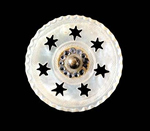
- A Button made from Shell
- Copper, Glass and Brass c. 1790-1800
Birmingham Museum & Art Gallery
[click on the picture to enlarge it]
Photo by Birmingham Museums Trust, licensed under CC0
https://www.birminghammuseums.org.uk/
https://www.revolutionaryplayers.org.uk/
In the 18th and 19th centuries the manufacture of “toys” was a major industry in Birmingham. But these “toys” had nothing to do with children’s games. The term “Birmingham toys” refers to a multitude of small, decorative personal accessories. Their production provided work for thousands, gained major export markets and led to the development of manufacturing techniques which could be applied in other fields. Birmingham’s first directory, Sketchley’s Directory of 1767, lists 100 firms in the “toy” and related trades and describes the industry as follows: ….for the information of Strangers we shall here observe, that these Articles are divided into several Branches, as the Gold and Silver Toy Makers, who make Trinkets, Seals, Tweezer and Tooth Pick cases, Smelling Bottles, Snuff Boxes, and Filigree Work, such as Toilets, Tea Chests, Inkstands, etc. etc. The Tortoise Toy maker, makes a beautiful variety of the above and other Articles; as does also the Steel, who makes Cork Screws, Buckles, Draw and other Boxes, Snuffers, Watch Chains, Stay Hooks, Sugar Nippers, etc., and almost all these are likewise made in various Metals, and for Cheapness, Beauty and Elegance no Place in the world can vie with them.1
1Sketchleys Birmingham Directory, 1767

